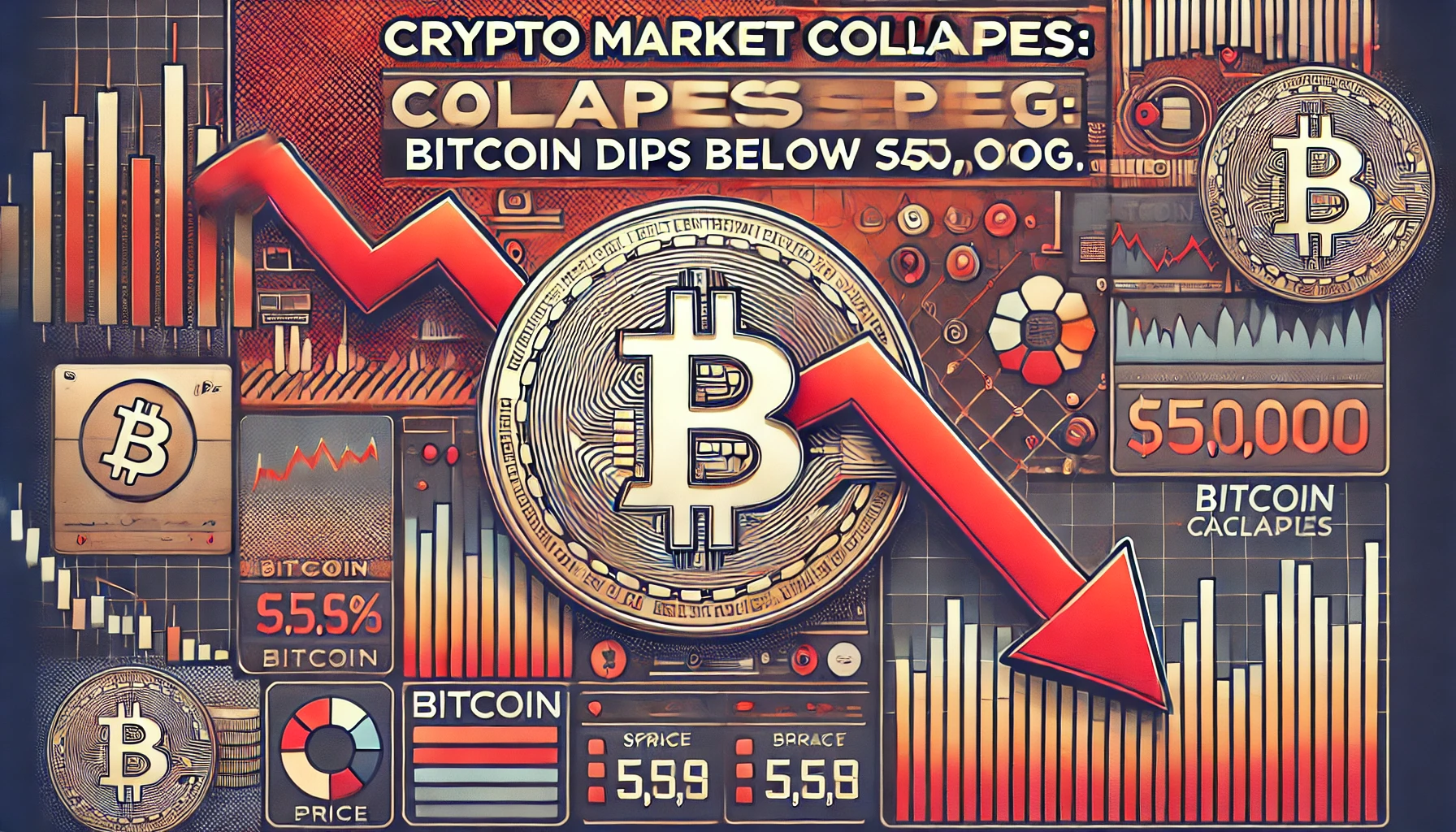Introduction

The crypto market has experienced a significant collapse, with Bitcoin dipping below $50,000. This decline marks a substantial downturn for the leading cryptocurrency, impacting investors and the broader market. This blog post delves into the details of this event, its context, and its potential implications, while keeping an eye on the trends via a reliable crypto market tracker.
What Happened

The crypto market has recently witnessed a massive sell-off, causing Bitcoin to dip below $50,000. This decline was driven by various factors, including geopolitical tensions, a stronger Japanese yen, and rumors of market maker Jump Trading liquidating its crypto business. Over $1 billion in liquidations occurred across crypto-tracked futures (markets.businessinsider.com) (ABP Live).
Crypto Market Data (August 5-6, 2024):
| Cryptocurrency | Price | 24-Hour Loss |
|---|---|---|
| Bitcoin (BTC) | $50,000 | 11% |
| Ethereum (ETH) | $2,500 | 25% |
| Solana (SOL) | $130.91 | 3% |
| Dogecoin (DOGE) | $0.094 | 7.66% |
The market collapse was marked by a series of cascading events that amplified each other. Initially, geopolitical tensions in the Middle East created a wave of uncertainty. As Iran and Israel’s conflict escalated, investors sought safer assets, leading to a sell-off in riskier assets like cryptocurrencies. Concurrently, the Japanese yen surged to seven-month highs due to the Bank of Japan’s unexpected rate hike, tightening global liquidity and further straining the market (Cryptonews) (Cryptonews).
For additional resources for crypto market collapse, watch this video:
When and Where

The market collapse occurred on August 5-6, 2024. The downturn affected global markets, with significant impacts seen in the United States and Asia. The crypto market sell-off began last week and intensified due to multiple external factors. The Federal Reserve’s decision to maintain high interest rates exacerbated fears of a potential recession, contributing to the broader sell-off (markets.businessinsider.com) (ABP Live).
Who is Involved

Key figures and organizations involved include the US Federal Reserve, the Bank of Japan, and market maker Jump Trading. The Federal Reserve’s decision to maintain high interest rates and the Bank of Japan’s rate hike contributed to the market downturn. Additionally, Jump Trading’s rumored liquidation of its crypto assets amplified the sell-off. Traders and investors across the globe, from institutional investors to retail traders, were significantly affected by this market turmoil (markets.businessinsider.com) (Cryptonews) (CryptoNews) (ABP Live).
Why It Matters

The crypto market collapse has significant implications for investors and the broader financial market. The sudden drop in Bitcoin and other cryptocurrencies has led to substantial financial losses for many traders. This event also raises questions about the stability and future of the crypto market. Potential outcomes include increased regulatory scrutiny and a shift in investor confidence.
Potential Outcomes:
- Increased regulatory scrutiny.
- Decline in investor confidence.
- Potential for market stabilization.
- Opportunities for buying the dip.
The drop has also triggered a wave of margin calls, forcing traders to liquidate their positions to meet their obligations. This has created a downward spiral, where the forced selling leads to further price declines, triggering more margin calls. Additionally, the crypto fear and greed index has plunged, indicating extreme fear in the market. This sentiment could lead to further selling pressure as investors move to safer assets (Cryptonews) (ABP Live).
Detailed Analysis
The current crypto market collapse can be attributed to a confluence of macroeconomic and geopolitical factors. The US Federal Reserve’s decision to maintain high interest rates has heightened fears of a potential recession. This decision has led to a flight away from risky assets, including cryptocurrencies. Simultaneously, the Bank of Japan’s unexpected rate hike tightened global liquidity, further exacerbating the sell-off.
Moreover, geopolitical tensions in the Middle East have added to market instability. The ongoing conflict between Iran and Israel has created an atmosphere of uncertainty, prompting investors to seek safer assets. Additionally, the Japanese yen’s surge to seven-month highs has influenced market dynamics, as traders unwind carry trades and reposition their portfolios (markets.businessinsider.com) (Cryptonews) (Cryptonews).
The liquidation of over $1 billion in crypto futures positions has been particularly impactful. These liquidations occur when traders who use leverage are forced to sell their positions due to margin calls. As prices drop, more positions get liquidated, causing a cascading effect that drives prices down further. The largest single liquidation order, worth $27 million, was recorded on Huobi, a major crypto exchange (markets.businessinsider.com) (ABP Live).
Quotes or Statements
Edul Patel, CEO of Mudrex, stated, “Bitcoin’s drop below $50,000 reflects broader market fears. However, its recovery to $55,000 shows resilience and investor confidence.” Shivam Thakral, CEO of BuyUcoin, added, “The recent volatility underscores the need for a long-term perspective on crypto investments” (ABP Live).
Sathvik Vishwanath, CEO of Unocoin, mentioned, “Bitcoin’s rebound to $56,000 showcases the market’s resilience despite significant volatility. This recovery indicates strong investor confidence in the long-term potential of digital assets” (ABP Live).
Conclusion
The crypto market collapse, with Bitcoin dipping below $50,000, marks a significant event in the financial landscape. This downturn has affected investors worldwide, raising concerns about market stability and future trends. As the market recovers, stakeholders must navigate these challenges to ensure long-term growth and stability.
References
- IOL Business Report. (2024). Bitcoin a casualty of global market slump. Retrieved from https://www.iol.co.za/business-report/markets/bitcoin-a-casualty-of-global-market-slump-faebfa48-1f07-44e1-a5f5-91159c8103c0
- MSN. (2024). Bitcoin price crash: Why is the crypto market collapsing? Retrieved from https://www.msn.com/en-gb/money/other/bitcoin-price-crash-why-is-the-crypto-market-collapsing/ar-AA1ogzZi?ocid=BingNewsVerp
- FXStreet. (2024). Bitcoin bleeds under $50,000 amidst global stock market sell-off. Retrieved from https://www.fxstreet.com/cryptocurrencies/news/bitcoin-bleeds-under-50-000-amidst-global-stock-market-sell-off-what-to-expect-from-the-btc-cycle-202408051220
- MSN. (2024). Global crypto market sees massive drop in market cap. Retrieved from https://www.msn.com/en-in/money/topstories/global-crypto-market-sees-massive-drop-in-market-cap-as-bitcoin-briefly-goes-below-50000/ar-AA1og8iG?ocid=BingNewsVerp

